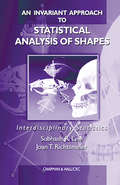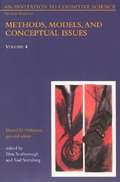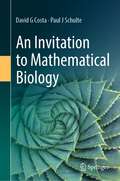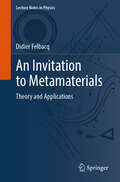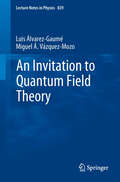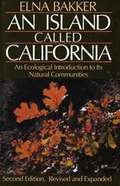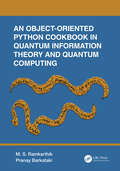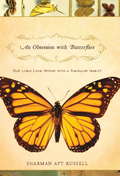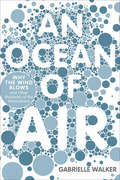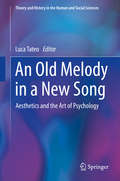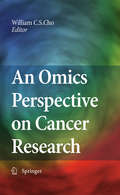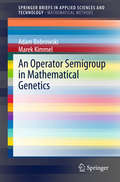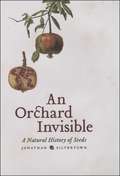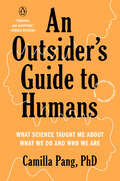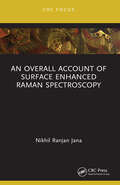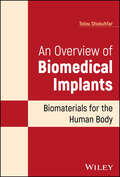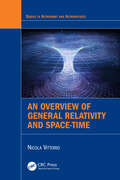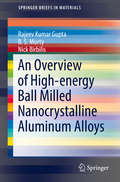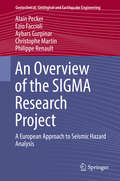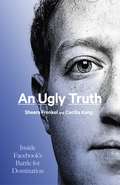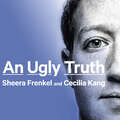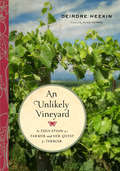- Table View
- List View
An Invariant Approach to Statistical Analysis of Shapes (Chapman & Hall/CRC Interdisciplinary Statistics)
by Subhash R. Lele Joan T. RichtsmeierNatural scientists perceive and classify organisms primarily on the basis of their appearance and structure- their form , defined as that characteristic remaining invariant after translation, rotation, and possibly reflection of the object. The quantitative study of form and form change comprises the field of morphometrics. For morphometrics to suc
An Invitation to Cognitive Science, Volume 4 (2nd edition)
by Daniel N. OshersonThe 4th volume of the series, which covers Methods, Models, and Conceptual Issues.
An Invitation to Cognitive Science, Volumes 1-3 (2nd edition)
by Edward E. Smith Daniel N. OshersonThe first three volumes of a four-volume introduction to contemporary cognitive science. The volumes are self-contained, and can be used individually in a variety of advanced undergraduate and graduate courses.
An Invitation to Mathematical Biology
by David G Costa Paul J SchulteThe textbook is designed to provide a "non-intimidating" entry to the field of mathematical biology. It is also useful for those wishing to teach an introductory course. Although there are many good mathematical biology texts available, most books are too advanced mathematically for most biology majors. Unlike undergraduate math majors, most biology major students possess a limited math background. Given that computational biology is a rapidly expanding field, more students should be encouraged to familiarize themselves with this powerful approach to understand complex biological phenomena. Ultimately, our goal with this undergraduate textbook is to provide an introduction to the interdisciplinary field of mathematical biology in a way that does not overly terrify an undergraduate biology major, thereby fostering a greater appreciation for the role of mathematics in biology
An Invitation to Metamaterials: Theory and Applications (Lecture Notes in Physics #1037)
by Didier FelbacqThis book provides a thorough introduction to the fundamental principles and cutting-edge applications of metamaterials. It offers a balanced perspective, combining theoretical, experimental, and computational approaches. Topics covered include rapidly evolving areas such as metasurfaces, quantum metamaterials, and nonlinear metamaterials. The book also extends its scope beyond optics to explore applications in acoustics, thermal science, mechanics, and even seismology. A dedicated chapter discusses topological insulators, providing detailed insights into this advanced topic. The text is designed for advanced graduate students and early career researchers in the field of metamaterials. Specialists in the field will also benefit from the book's presentation of new developments and innovative approaches. Two chapters focus on advanced mathematical methods, including fiber bundles, Chern numbers, pseudodifferential operators, and scattering theory. These sections are crafted to be reasonably self-contained, with references provided for readers who wish to explore these topics further.
An Invitation to Quantum Field Theory (Lecture Notes in Physics #839)
by Luis Alvarez-Gaumé Miguel A. Vázquez-MozoThis book provides an introduction to Quantum Field Theory (QFT) at an elementary level--with only special relativity, electromagnetism and quantum mechanics as prerequisites. For this fresh approach to teaching QFT, based on numerous lectures and courses given by the authors, a representative sample of topics has been selected containing some of the more innovative, challenging or subtle concepts. They are presented with a minimum of technical details, the discussion of the main ideas being more important than the presentation of the typically very technical mathematical details necessary to obtain the final results. Special attention is given to the realization of symmetries in particle physics: global and local symmetries, explicit, spontaneously broken, and anomalous continuous symmetries, as well as discrete symmetries. Beyond providing an overview of the standard model of the strong, weak and electromagnetic interactions and the current understanding of the origin of mass, the text enumerates the general features of renormalization theory as well as providing a cursory description of effective field theories and the problem of naturalness in physics. Among the more advanced topics the reader will find are an outline of the first principles derivation of the CPT theorem and the spin-statistics connection. As indicated by the title, the main aim of this text is to motivate the reader to study QFT by providing a self-contained and approachable introduction to the most exciting and challenging aspects of this successful theoretical framework.
An Island Called California
by Elna BakkerBakker’s classic of ecological science now includes three new chapters on Southern California which make the book more useful than ever. Striking new photographs illustrate the diversity of life, climate, and geological formation.
An Object-Oriented Python Cookbook in Quantum Information Theory and Quantum Computing
by M.S. Ramkarthik Pranay BarkatakiThis first-of-a-kind textbook provides computational tools in state-of-the-art OOPs Python that are fundamental to quantum information, quantum computing, linear algebra and one-dimensional spin half condensed matter systems. Over 104 subroutines are included, and the codes are aided by mathematical comments to enhance clarity. Suitable for beginner and advanced readers alike, students and researchers will find this textbook to be a helpful guide and a compendium which they can readily use.Features Includes over 104 codes in OOPs Python, all of which can be used either as a standalone program or integrated with any other main program without any issues. Every parameter in the input, output and execution has been provided while keeping both beginner and advanced users in mind. The output of every program is explained thoroughly with detailed examples. Detailed mathematical commenting is done alongside the code which enhances clarity about the flow and working of the code.
An Obsession With Butterflies: Our Long Love Affair With A Singular Insect
by Sharman Apt RussellButterflies have always served as a metaphor for resurrection and transformation, but as Sharman Apt Russell points out in this lyrical meditation, butterflies are above all objects of obsession. She reveals the logic behind our endless fascination with butterflies and introduces us to the legendary collectors and dedicated scientists who have obsessively catalogued new species of Lepidoptera. A luminous journey through an exotic world of passion and strange beauty, this is a book to be treasured by anyone who has ever experienced the enchantment of butterflies.
An Ocean of Air: Why the Wind Blows and Other Mysteries of the Atmosphere (Read-On)
by Gabrielle WalkerThe science and history of what lies between us and space: “I never knew air could be so interesting.” —Bill Bryson, New York Times bestselling author of The Body: A Guide for OccupantsA flamboyant Renaissance Italian discovers how heavy our air really is (the air filling Carnegie Hall, for example, weighs seventy thousand pounds). A one-eyed barnstorming pilot finds a set of winds that constantly blow five miles above our heads. An impoverished American farmer figures out why hurricanes move in a circle by carving equations with his pitchfork on a barn door. A well-meaning inventor nearly destroys the ozone layer (he also came up with the idea of putting lead in gasoline). A reclusive mathematical genius predicts, thirty years before he’s proven right, that the sky contains a layer of floating metal fed by the glowing tails of shooting stars.We don’t just live in the air; we live because of it. It’s the most miraculous substance on earth, responsible for our food, our weather, our water, and our ability to hear. In this exuberant book, science writer Gabrielle Walker peels back the layers of our atmosphere with the stories of the people who have uncovered its secrets.“A sense of wonder . . . animates Ms. Walker’s high-spirited narrative and speeds it along like a fresh-blowing westerly.” —The New York Times“A fabulous introduction to the world above our heads.” —Daily Mail on Sunday“A lively history of scientists’ and adventurers’ exploration of this important and complex contributor to life on Earth . . . readers will find this informative book to be a breath of fresh air.” —Publishers Weekly
An Old Melody in a New Song: Aesthetics and the Art of Psychology (Theory and History in the Human and Social Sciences)
by Luca TateoThis book explores the relationship between cultural psychology and aesthetics, by integrating the historical, theoretical and phenomenological perspectives. It offers a comprehensive discussion of the history of aesthetics and psychology from an international perspective, with contributions by leading researchers from Serbia, Austria, Portugal, Norway, Denmark, and Brazil. The first section of the book aims at summarizing the debate of where the song comes from. It discusses undeveloped topics, methodological hints, and epistemological questions in the different areas of contemporary psychological sciences. The second section of the book presents concrete examples of case-studies and methodological issues (the new melodies in psychological research) to stimulate further explorations. The book aims to bring art back into psychology, to provide an understanding for the art of psychology. An Old Melody in a New Song will be of interest to advanced students and researchers in the fields of educational and developmental psychology, cultural psychology, history of ideas, aesthetics, and art-based research.
An Omics Perspective on Cancer Research
by William C.S. ChoOmics is an emerging and exciting area in the field of science and medicine. Numerous promising developments have been elucidated using omics (including genomics, transcriptomics, epigenomics, proteomics, metabolomics, interactomics, cytomics and bioinformatics) in cancer research. The development of high-throughput technologies that permit the solution of deciphering cancer from higher dimensionality will provide a knowledge base which changes the face of cancer understanding and therapeutics. This is the first book to provide such a comprehensive coverage of a rapidly evolving area written by leading experts in the field of omics. It complies and details cutting-edge cancer research that covers the broad advances in the field and its application from cancer-associated gene discovery to drug target validation. It also highlights the potential of using integration approach for cancer research. This unique and timely book provides a thorough overview of developing omics, which will appeal to anyone involved in cancer research. It will be a useful reference book for graduate students of different subjects (medicine, biology, engineering, etc) and senior scientists interested in the fascinating area of advanced technologies in cancer research. Readership: This is a precious book for all types of readers - cancer researchers, oncologists, pathologists, biologists, clinical chemists, pharmacologists, pharmaceutical specialists, biostatisticians, and bioinformaticists who want to expand their knowledge in cancer research.
An Operator Semigroup in Mathematical Genetics: Lyapunov Equation Model Of Drift And Mutation: Population Dependence And Asymptotic Behavior (SpringerBriefs in Applied Sciences and Technology)
by Marek Kimmel Adam BobrowskiThis authored monograph presents a mathematical description of the time evolution of neutral genomic regions in terms of the differential Lyapunov equation. The qualitative behavior of its solutions, with respect to different mutation models and demographic patterns, can be characterized using operator semi group theory. Mutation and drift are two of the main genetic forces, which act on genes of individuals in populations. Their effects are influenced by population dynamics. This book covers the application to two mutation models: single step mutation for microsatellite loci and single-base substitutions. The effects of demographic change to the asymptotic of the distribution are also covered. The target audience primarily covers researchers and experts in the field but the book may also be beneficial for graduate students.
An Orchard Invisible: A Natural History of Seeds
by Jonathan SilvertownThe story of seeds, in a nutshell, is a tale of evolution. From the tiny sesame that we sprinkle on our bagels to the forty-five-pound double coconut borne by the coco de mer tree, seeds are a perpetual reminder of the complexity and diversity of life on earth. With An Orchard Invisible, Jonathan Silvertown presents the oft-ignored seed with the natural history it deserves, one nearly as varied and surprising as the earth's flora itself.Beginning with the evolution of the first seed plant from fernlike ancestors more than 360 million years ago, Silvertown carries his tale through epochs and around the globe. In a clear and engaging style, he delves into the science of seeds: How and why do some lie dormant for years on end? How did seeds evolve? The wide variety of uses that humans have developed for seeds of all sorts also receives a fascinating look, studded with examples, including foods, oils, perfumes, and pharmaceuticals. An able guide with an eye for the unusual, Silvertown is happy to take readers on unexpected--but always interesting--tangents, from Lyme disease to human color vision to the Salem witch trials. But he never lets us forget that the driving force behind the story of seeds-- its theme, even-- is evolution, with its irrepressible habit of stumbling upon new solutions to the challenges of life. "I have great faith in a seed," Thoreau wrote. "Convince me that you have a seed there, and I am prepared to expect wonders." Written with a scientist's knowledge and a gardener's delight, An Orchard Invisible offers those wonders in a package that will be irresistible to science buffs and green thumbs alike.
An Outsider's Guide to Humans: What Science Taught Me About What We Do and Who We Are
by Camilla PangWINNER OF THE ROYAL SOCIETY SCIENCE BOOK PRIZEAn instruction manual for life, love, and relationships by a brilliant young scientist whose Asperger's syndrome allows her--and us--to see ourselves in a different way...and to be better at being humanDiagnosed with Autism Spectrum Disorder at the age of eight, Camilla Pang struggled to understand the world around her. Desperate for a solution, she asked her mother if there was an instruction manual for humans that she could consult. With no blueprint to life, Pang began to create her own, using the language she understands best: science. That lifelong project eventually resulted in An Outsider's Guide to Humans, an original and incisive exploration of human nature and the strangeness of social norms, written from the outside looking in--which is helpful to even the most neurotypical thinker. Camilla Pang uses a set of scientific principles to examine life's everyday interactions:- How machine learning can help us sift through data and make more rational decisions- How proteins form strong bonds, and what they teach us about embracing individual differences to form diverse groups- Why understanding thermodynamics is the key to seeking balance over seeking perfection- How prisms refracting light can keep us from getting overwhelmed by our fears and anxieties, breaking them into manageable and separate "wavelengths"Pang's unique perspective of the world tells us so much about ourselves--who we are and why we do the things we do--and is a fascinating guide to living a happier and more connected life.
An Overall Account of Surface Enhanced Raman Spectroscopy
by Nikhil Ranjan JanaThis book covers all the aspects of surface enhanced Raman Spectroscopy (SERS) including a brief history of the discovery of SERS and development of the field, basic principles and enhancement mechanism of SERS. It covers first generation (plasmonic nanomaterials) /second generation (plasmonic hot spots)/third generation (via plasmonic engineering) substrate nanomaterials that are developed for SERS, single molecule SERS and designed SERS probes for ultrasensitive detection applications. It further discusses different SERS detection platforms, highlight the issues of poor signal reproducibility and how to minimize it.Features: Provides understanding on the role of electromagnetic hot spots in surface enhanced Raman Spectroscopy. Reviews all types of surface enhanced Raman Spectroscopy substrates. Covers surface enhanced Raman Spectroscopy-based detection platforms and signal reproducibility issues. Includes development of single molecule detection via surface enhanced Raman Spectroscopy. Discusses chemical analysis, biomedical application, and all other related applications. This book is aimed at graduate students and researchers in spectroscopy, materials science, and engineering.
An Overview of Biomedical Implants: Biomaterials for the Human Body
by Tolou ShokuhfarUnderstand the core materials that create biomedical innovation Some of the greatest medical advances in recent decades have come in the form of biomedical implants. Whether in the form of traditional orthopedic implants, medical devices for the cardiovascular system, or polymer-based ocular implants, biomedical implants can be lifesaving or life-transforming interventions. The biomaterials which comprise these implants are a vital area of ongoing research, but no prior volume has ever taken comprehensive stock of this subject and its growing applications. An Overview of Biomedical Implants fills this gap with a thorough overview of all major biomaterials and their role in biomedical implants. Composed for an interdisciplinary audience, the book addresses all scales and areas of application. The result is an essential resource in this critical ongoing area of biomedical research. An Overview of Biomedical Implants readers will also find: Description of the relationship between every specific biomaterial and its role in each major implant categoryDetailed discussion of nanoscale to molecular-scale to industrial-scale biomaterialsConcrete examples in every chapter, along with a list of pertinent references An Overview of Biomedical Implants is ideal for physicians, scientists, and engineers—those working in the area of biomaterials, medical, biological and chemical and applied physics, pharmaceutical science and as a reference for professors and students in these areas.
An Overview of General Relativity and Space-Time (Series in Astronomy and Astrophysics)
by Nicola VittorioThis textbook equips Masters’ students studying Physics and Astronomy with the necessary mathematical tools to understand the basics of General Relativity and its applications. It begins by reviewing classical mechanics with a more geometrically oriented language, continues with Special Relativity and, then onto a discussion on the pseudo-Riemannian space-times. Applications span from the inner and outer Schwarzschild solutions to gravitational wave, black holes, spherical relativistic hydrodynamics, and Cosmology. The goal is to limit the abstract formalization of the problems, to favor a hands-on approach with a number of exercises, without renouncing to a pedagogical derivation of the main mathematical tools and findings.
An Overview of High-energy Ball Milled Nanocrystalline Aluminum Alloys (SpringerBriefs in Materials)
by Nick Birbilis Rajeev Kumar Gupta B. S. MurtyThis book presents a comprehensive overview of the nanocrystalline Al based alloys as prepared using high-energy ball milling (HEBM). It discusses the influence of HEBM parameters on grain refinement and examines methods for the consolidation of nanocrystalline Al powders; further, it reviews the effects of various processing parameters on the final microstructure and the impact of microstructure on corrosion and mechanical properties. The book also provides guidelines for choosing appropriate HEBM parameters for the production of nanocrystalline Al powders and methods for consolidating them in net-shaped components. Future challenges and possible applications of high-energy ball milled Al alloys are also discussed. The book is intended for researchers and professionals interested in aluminium alloy development, manufacturing technologies, light metals and nanocrystalline metallic materials.
An Overview of the SIGMA Research Project: A European Approach to Seismic Hazard Analysis (Geotechnical, Geological and Earthquake Engineering #42)
by Alain Pecker Ezio Faccioli Aybars Gurpinar Christophe Martin Philippe RenaultThis book presents a summary of the important outcomes of the SIGMA project related to all aspects of Probabilistic Seismic Hazard Assessment: source characterization, rock motion characterization, site response characterization, and hazard calculations, with for all of them emphasis on the treatment of uncertainties. In recent years, attempts have been made to identify and quantify uncertainties in seismic hazard estimations for regions with moderate seismicity. These uncertainties, for which no estimation standards exist, create major difficulties and can lead to different interpretations and divergent opinions among experts. To address this matter, an international research project was launched in January 2011, by an industrial consortium composed of French and Italian organizations. This program, named SIGMA (Seismic Ground Motion Assessment) lasted for five years and involved a large number of international institutions. This book is intended for instructors running courses on engineering seismology, graduate students in the same field and practicing engineers involved in Probabilistic Seismic Hazard Analyses.
An Owl at Sea
by Susan Vande GriekThe extraordinary, true story of an owl stranded on the deck of an oil rig one hundred miles from shore, and the Good Samaritans who shepherded it home.This is the true story of a Short-eared Owl that plummeted onto the deck of an oil rig in the North Sea, one hundred miles from shore. Weak and tired, it huddled on the deck until riggers provided it with a makeshift shelter and fresh meat to eat. When a helicopter arrived to transport some of the workers back home, they took the owl with them, handing it over to the Scottish SPCA. A few weeks later the owl was strong enough to be released into the countryside.Susan Vande Griek’s gentle prose poem describes this unusual encounter with a creature from the wild with curiosity and wonder. Ian Wallace’s stunning watercolors show gorgeous seascapes, the subtle beauty of the owl, and the oil rig and its workers, creating compelling visual contrasts.An author’s note includes information about the Short-eared Owl, a bird found in the Americas, Europe and Asia, whose numbers may be in decline due to loss of habitat.Key Text Featuresauthor’s notefurther readingsourcesCorrelates to the Common Core State Standards in English Language Arts:CCSS.ELA-LITERACY.RL.1.2Retell stories, including key details, and demonstrate understanding of their central message or lesson.CCSS.ELA-LITERACY.RL.1.4Identify words and phrases in stories or poems that suggest feelings or appeal to the senses.CCSS.ELA-LITERACY.RL.1.5Explain major differences between books that tell stories and books that give information, drawing on a wide reading of a range of text types.CCSS.ELA-LITERACY.RL.2.3Describe how characters in a story respond to major events and challenges.CCSS.ELA-LITERACY.RL.2.4Describe how words and phrases (e.g., regular beats, alliteration, rhymes, repeated lines) supply rhythm and meaning in a story, poem, or song.CCSS.ELA-LITERACY.RL.2.7Use information gained from the illustrations and words in a print or digital text to demonstrate understanding of its characters, setting, or plot.
An Ugly Truth: Inside Facebook's Battle for Domination
by Sheera Frenkel Cecilia Kang'The ultimate takedown' New York Times'The problem of Facebook is Zuckerberg. And the question posed by this splendid book is: what are we going to do about him?' Observer'A comprehensive account . . . drawn from first-hand testimonies. Thoroughly engaging' The Times'What marks this book out is how it gets under the corporate bonnet . . . to build a picture of astounding corporate arrogance and irresponsibility' Sunday Times'An explosive new book' Daily Mail__________________________________________Award-winning New York Times reporters Sheera Frenkel and Cecilia Kang unveil the tech story of our times in a riveting, behind-the-scenes exposé that offers the definitive account of Facebook's fall from grace. Once one of Silicon Valley's greatest success stories, for the past five years, Facebook has been under constant fire, roiled by controversies and crises. It turns out that while the tech giant was connecting the world, they were also mishandling users' data, allowing the spread of fake news, and the amplification of dangerous, polarising hate speech. Critics framed the narrative as the irreconcilable conflict between the platform's lofty mission to advance society by bringing people together while also profiting off of them. The company, many said, had simply lost its way. But the truth is far more complex. Drawing on their unrivalled sources, Frenkel and Kang take readers inside the complex court politics, alliances and rivalries within the company, its growing political influence as well as its skirmishes with privacy groups and the FTC, to shine a light on the fatal cracks in the architecture of the tech behemoth. Their explosive, exclusive reporting led them to a shocking conclusion: The missteps of the last five years were not an anomaly but an inevitability - this is how the platform was built to perform. In a period of great upheaval, growth has remained the one constant under the leadership of Mark Zuckerberg and Sheryl Sandberg. Each has stood by as their technology is co-opted by hate-mongers, criminals and corrupt political regimes across the globe, with devastating consequences. In An Ugly Truth, they are at last held accountable.
An Ugly Truth: Inside Facebook's Battle for Domination (Language Acts and Worldmaking #29)
by Sheera Frenkel Cecilia Kang'The ultimate takedown' New York Times'The problem of Facebook is Zuckerberg. And the question posed by this splendid book is: what are we going to do about him?' Observer'A comprehensive account . . . drawn from first-hand testimonies. Thoroughly engaging' The Times'What marks this book out is how it gets under the corporate bonnet . . . to build a picture of astounding corporate arrogance and irresponsibility' Sunday Times'An explosive new book' Daily Mail__________________________________________Award-winning New York Times reporters Sheera Frenkel and Cecilia Kang unveil the tech story of our times in a riveting, behind-the-scenes exposé that offers the definitive account of Facebook's fall from grace. Once one of Silicon Valley's greatest success stories, for the past five years, Facebook has been under constant fire, roiled by controversies and crises. It turns out that while the tech giant was connecting the world, they were also mishandling users' data, allowing the spread of fake news, and the amplification of dangerous, polarising hate speech. Critics framed the narrative as the irreconcilable conflict between the platform's lofty mission to advance society by bringing people together while also profiting off of them. The company, many said, had simply lost its way. But the truth is far more complex. Drawing on their unrivalled sources, Frenkel and Kang take readers inside the complex court politics, alliances and rivalries within the company, its growing political influence as well as its skirmishes with privacy groups and the FTC, to shine a light on the fatal cracks in the architecture of the tech behemoth. Their explosive, exclusive reporting led them to a shocking conclusion: The missteps of the last five years were not an anomaly but an inevitability - this is how the platform was built to perform. In a period of great upheaval, growth has remained the one constant under the leadership of Mark Zuckerberg and Sheryl Sandberg. Each has stood by as their technology is co-opted by hate-mongers, criminals and corrupt political regimes across the globe, with devastating consequences. In An Ugly Truth, they are at last held accountable.
An Unlikely Vineyard
by Alice Feiring Deirdre HeekinAn Unlikely Vineyard tells the evolutionary story of Deirdre Heekin's farm from overgrown fields to a fertile, productive, and beautiful landscape that melds with its natural environment. Is it possible to capture landscape in a bottle? To express its terroir, its essence of place--geology, geography, climate, and soil--as well as the skill of the winegrower? That's what Heekin and her chef/husband, Caleb Barber, set out to accomplish on their tiny, eight-acre hillside farm and vineyard in Vermont. But An Unlikely Vineyard involves much more. It also presents, through the example of their farming journey and winegrowing endeavors, an impressive amount of information on how to think about almost every aspect of gardening: from composting to trellising; from cider and perry making to growing old garden roses, keeping bees, and raising livestock; from pruning (or not) to dealing naturally with pests and diseases. Challenged by cold winters, wet summers, and other factors, Deirdre and Caleb set about to grow not only a vineyard, but an orchard of heirloom apples, pears, and plums, as well as gardens filled with vegetables, herbs, roses, and wildflowers destined for their own table and for the kitchen of their small restaurant. They wanted to create, or rediscover, a sense of place, and to grow food naturally using the philosophy and techniques gleaned from organic gardening, permaculture, and biodynamic farming. Accompanied throughout by lush photos, this gentle narrative will appeal to anyone who loves food, farms, and living well.
An Unnatural Metropolis: Wresting New Orleans from Nature
by Craig E. ColtenStrategically situated at the gateway to the Mississippi River yet standing atop a former swamp, New Orleans was from the first what geographer Peirce Lewis called an "impossible but inevitable city." How New Orleans came to be, taking shape between the mutual and often contradictory forces of nature and urban development, is the subject of An Unnatural Metropolis. Craig E. Colten traces engineered modifications to New Orleans's natural environment from 1800 to 2000 and demonstrates that, though all cities must contend with their physical settings, New Orleans may be the city most dependent on human-induced transformations of its precarious site. In a new preface, Colten shows how Hurricane Katrina exemplifies the inability of human artifice to exclude nature from cities and he urges city planners to keep the environment in mind as they contemplate New Orleans's future. Urban geographers frequently have portrayed cities as the antithesis of nature, but in An Unnatural Metropolis, Colten introduces a critical environmental perspective to the history of urban areas. His amply illustrated work offers an in-depth look at a city and society uniquely shaped by the natural forces it has sought to harness.
